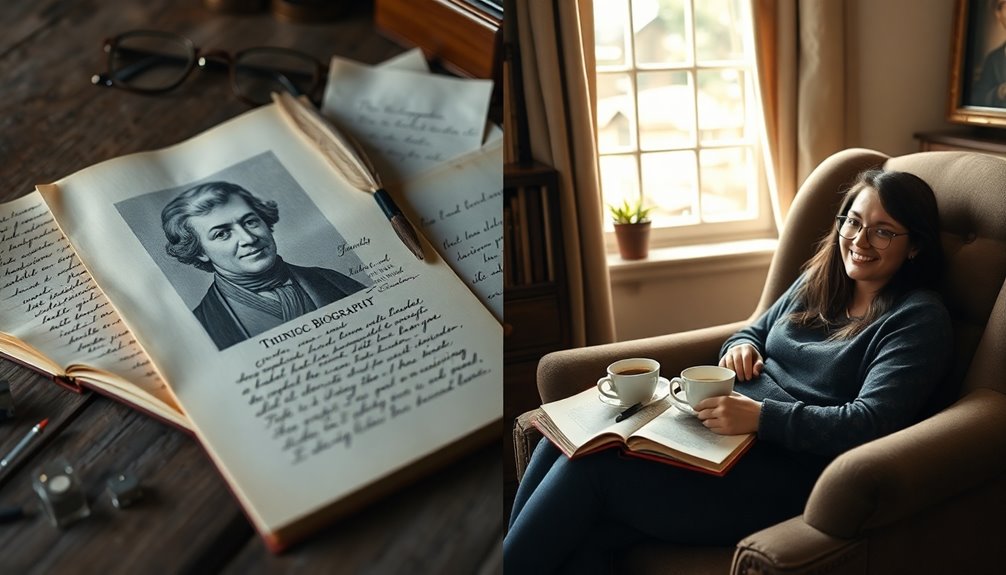A biography is written by someone else and provides an objective overview of a person's life, often based on thorough research. On the other hand, an autobiography is your own story, told in your voice, offering an intimate glimpse into your thoughts and experiences. Biographies use a third-person perspective to maintain distance, while autobiographies are first-person, creating a personal connection. Fundamentally, biographies are factual and research-driven, whereas autobiographies focus on emotional and personal narratives. If you keep exploring, you'll uncover additional nuances between these two fascinating forms of storytelling.
Key Takeaways
- A biography is written by an external author, while an autobiography is authored by the subject themselves.
- Biographies use a third-person perspective for objectivity; autobiographies utilize a first-person perspective for personal insight.
- Biographies present a chronological overview of a subject's life, whereas autobiographies often focus on specific themes and personal experiences.
- Biographies aim to educate and inspire through factual narratives, while autobiographies seek emotional connection and personal reflection.
- Biographies appeal to readers interested in historical figures, while autobiographies engage those seeking intimate, personal stories.
Authorship Differences

When it comes to authorship, a key difference sets biographies apart from autobiographies. In a biography, an external author tells the story of someone's life. This author isn't the subject of the narrative and often conducts extensive research, including interviews with people who know the individual. The biography can be either authorized, meaning the subject approves of it, or unauthorized, where the author works without the subject's consent. Typically, historians, journalists, or biographers take on this task, aiming to provide a thorough view of the subject's life.
On the other hand, an autobiography is written by the subject themselves. When you read an autobiography, you're diving into the author's personal memories and experiences. This self-narration guarantees that the story is uniquely theirs, reflecting their perspective. While some autobiographies may involve collaboration with a ghostwriter or editor, they are always authorized since the subject is the one crafting the narrative. Consequently, the distinction in authorship highlights the differing lenses through which lives are portrayed, whether through an external viewpoint or the intimate lens of the individual's own experience. Furthermore, biographies often rely on in-depth research to compile a comprehensive account of the subject's life.
Perspective Variations

Understanding authorship differences sets the stage for exploring perspective variations in biographies and autobiographies. In biographies, you'll find a third-person point of view that provides an external look at the subject's life. The biographer conducts research and interviews, crafting an objective narrative without personal thoughts or emotions from the subject. This method maintains a balanced tone, focusing on factual accuracy and avoiding bias. Biographies are typically based on gathered facts that present a comprehensive overview of the subject's life.
Conversely, autobiographies are written in the first person, offering an internal viewpoint. You get the author's personal thoughts and feelings, creating a more intimate narrative. The author controls the story, choosing which events to include based on their memories and experiences. This subjective approach often leads to a deeper emotional connection with readers, as they see the story through the author's eyes.
While biographies cater to a broader audience, offering an extensive view, autobiographies appeal to those seeking personal connections and insights into the author's life. Ultimately, the perspective you choose shapes your experience, whether you're observing from afar or diving deep into someone's personal journey.
Scope of Coverage
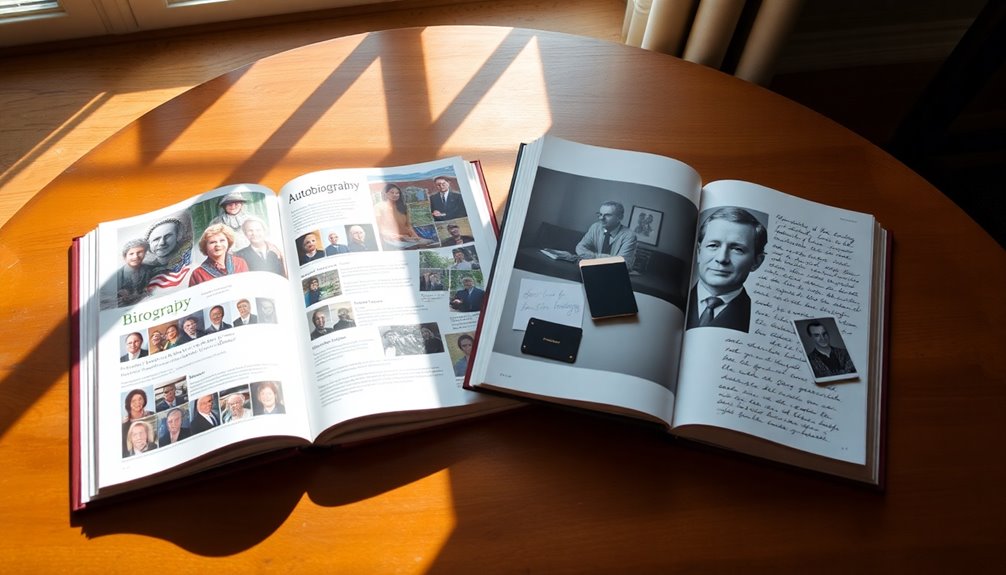
When you look at the scope of coverage in biographies, you see a thorough life overview that spans from birth to the present or death, capturing key milestones and context. In contrast, autobiographies offer a thematic focus, allowing authors to reflect on specific experiences and emotions that shaped their lives. This difference highlights how each form presents unique insights into the subject's journey. Biographies require extensive research for accurate and detailed representation of the subject's life events.
Comprehensive Life Overview
Both biographies and autobiographies provide a detailed life overview, but they do so in distinctly different ways. A biography covers the entire life of the subject, from birth to death or the present, including details about their birthplace, education, work history, and significant relationships. It encompasses both personal and professional aspects and often includes historical context, helping you understand the subject's impact on society and their achievements.
In contrast, an autobiography details the author's life up to the present, often starting from childhood. It highlights significant life events and the author's reactions and experiences, focusing on personal reflections and emotions. You'll find that autobiographies may employ various narrative structures, including flashbacks, and contain specific insights known only to the author. Notably, autobiographies rely on personal memories that may be subjective and lack external verification.
While biographies rely on extensive research, interviews, and records to provide an objective view, autobiographies draw on personal memories and memorabilia, often maintaining an emotional tone. Both genres aim to present a thorough and accurate account of a life, yet they do so through different perspectives and techniques, making each unique in its storytelling approach.
Thematic Focus Areas
In exploring thematic focus areas, you'll notice that autobiographies and biographies approach the subject's life from different angles. Autobiographies center on the author's personal experiences and reflections, focusing on their thoughts, feelings, and growth. They often investigate significant life events, connecting personal memories to broader themes while using personal memorabilia like letters and photographs.
On the other hand, biographies aim for objectivity, presenting a factual account of the subject's life. They cover various aspects, including personal, professional, and public dimensions, while maintaining a chronological narrative of events. Biographies rely on external research and multiple sources, ensuring a balanced and thorough portrayal. This thorough research is essential for capturing the complexities of the individual's life accurately.
Autobiographies tend to be more emotional and subjective, allowing readers to connect intimately with the author's perspective. They can structure the narrative thematically, highlighting specific life periods or themes. In contrast, biographies cater to a broader audience, providing insight into significant individuals' beliefs and accomplishments.
Ultimately, understanding these thematic focus areas helps you appreciate the distinct narrative styles and purposes of autobiographies versus biographies. Each offers unique insights into the human experience.
Tone and Style

Understanding the tone and style of biographies and autobiographies reveals key differences in how each type of narrative presents life stories. Biographies maintain an objective tone, steering clear of personal bias or emotional involvement. They focus on factual accuracy and often adopt a formal and detached style. You'll notice that biographies are written in the third person, using "he," "she," or "they," and they aim for a balanced, thorough account of the subject's life.
On the other hand, autobiographies tend to showcase a more emotional and personal tone. They reflect the author's subjective experiences, often including personal reflections and thoughts. When reading an autobiography, you'll find a first-person narrative, using "I" to share the author's story. This style often features detailed chronologies and personal anecdotes, allowing for a more intimate connection with the reader. Autobiographies can vary in formality, depending on the author's unique voice, and they may employ thematic or chronological organization of events. Overall, the tone and style of each type shape how you engage with their life stories. Notably, while autobiographies are always authorized accounts, biographies can be either authorized or unauthorized, affecting their presentation and depth of insight.
Research Methodologies
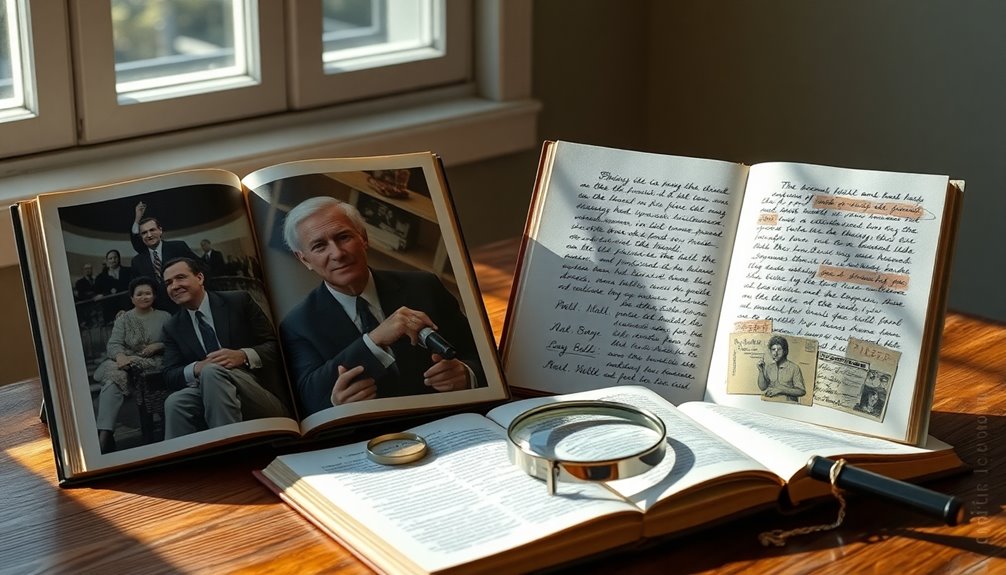
The research methodologies employed in biographies and autobiographies markedly influence how each narrative is constructed. In biographies, you gather information from a variety of external sources. This often includes interviews with people who knew the subject, along with a thorough review of records and documents. You meticulously verify facts through multiple sources, utilizing archives and libraries while collaborating with experts for accuracy.
In contrast, autobiographies draw heavily from primary sources—your personal memories and experiences. You might use personal documents like letters and diaries, along with reflections and anecdotes. Engaging in deep self-reflection allows you to analyze your growth and connect personal details to broader themes.
Both forms benefit from rigorous fact-checking and organization. Biographies tend to follow chronological or thematic structures, while autobiographies weave in storytelling elements, integrating personal insights with a coherent narrative. Collaborators might assist autobiographers in organizing thoughts and maintaining clarity.
Ultimately, the methodologies in both genres shape how you present the subject's life, ensuring that you provide an engaging and accurate account, whether it's from an external or personal perspective.
Audience Considerations

When you think about audience considerations, it's clear that biographies and autobiographies target different groups of readers. Biographies typically attract those interested in significant figures and their societal impact, while autobiographies engage readers looking for personal insights and emotional connections. Understanding these differences can help you choose the right book for your interests and reading goals.
Target Audience Differences
While both biographies and autobiographies aim to share life stories, their target audiences differ considerably. Biographies often cater to a broad range of readers who are interested in significant individuals. If you're curious about historical or public figures, you'll likely find biographies appealing. They provide educational insights, helping you understand the context and achievements of influential people. If you value detailed research and a balanced account, biographies will resonate with you.
On the other hand, autobiographies attract readers seeking a personal connection with the author. If you're drawn to intimate narratives that reveal personal thoughts and feelings, you'll prefer autobiographies. They offer reflective insights into the author's life experiences, making the narrative feel more authentic and relatable. You might find that the emotional resonance in autobiographies speaks to you on a deeper level, as they often convey the subjective nature of the author's journey.
Reader Engagement Levels
Reader engagement levels vary greatly between biographies and autobiographies, influencing how you connect with the narratives. Autobiographies pull you in with a personal touch, offering a first-person perspective that invites you to experience the author's thoughts and feelings. You'll find intimate details, emotional tones, and reflective insights that prompt you to reflect on your own life. In contrast, biographies present a balanced and factual account, relying on extensive research and multiple perspectives, appealing to those seeking a thorough understanding.
Here's a quick comparison of reader engagement in both genres:
| Engagement Aspect | Biography | Autobiography |
|---|---|---|
| Narrative Style | Objective and factual | Personal and emotional |
| Author's Control | Biographer interprets events | Author controls their narrative |
| Reader Connection | Engages through diverse viewpoints | Engages through personal reflection |
| Emotional Tone | Formal and professional | Intimate and relatable |
Understanding these differences can help you choose which style resonates more with you, enhancing your reading experience. Whether you seek factual depth or personal connection, each genre offers unique engagement opportunities.
Purpose of Reading
Understanding reader engagement helps clarify the purpose behind choosing a biography or autobiography. When you pick up a biography, you're likely seeking to immerse yourself in the life of a significant figure. Here are three key purposes you might have in mind:
- Inspiration: You might want to find motivation in the achievements and struggles of someone who's made a mark on history.
- Education: You could be looking to understand the cultural and historical contexts that shaped their life, gaining insight into their character and contributions.
- Research: If you're a student or researcher, you may seek extensive information to support your academic or professional work.
On the other hand, autobiographies draw you in with a personal touch. You might crave an intimate connection with the author's thoughts and feelings, allowing you to experience their journey firsthand. Reading an autobiography can help you reflect on personal growth or relate to specific life themes. Ultimately, whether you choose a biography or autobiography, both genres serve distinct purposes that cater to your curiosity and desire for understanding.
Purpose of Each Form
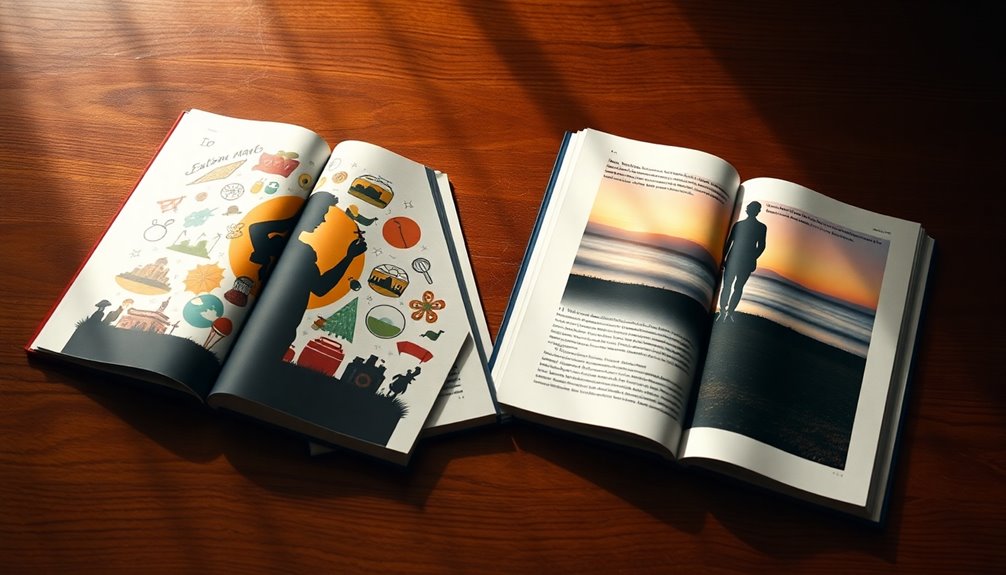
Exploring the purpose of biographies and autobiographies reveals distinct approaches to storytelling. Biographies aim to provide a thorough life account, detailing the subject's entire journey. They include historical and cultural context, helping you understand the environment in which the subject lived. By aiming for objectivity and accuracy, biographies present a balanced and factual portrayal, rooted in extensive research, including interviews and personal records. Their primary goal is to educate and inform you about the subject's life, achievements, and contributions.
On the other hand, autobiographies focus on personal reflection and insight. They offer an intimate narrative, allowing you to connect with the author's thoughts and feelings. Through self-reflection and growth, autobiographies give authors a chance to explore their life experiences and development. These narratives often serve as a legacy, providing future generations a glimpse into the author's life. With a more emotional and subjective tone, autobiographies reflect personal interpretations, making them resonate deeply with readers. Ultimately, while biographies inform, autobiographies invite you into the author's world, creating a unique space for connection and understanding.
Narrative Structure
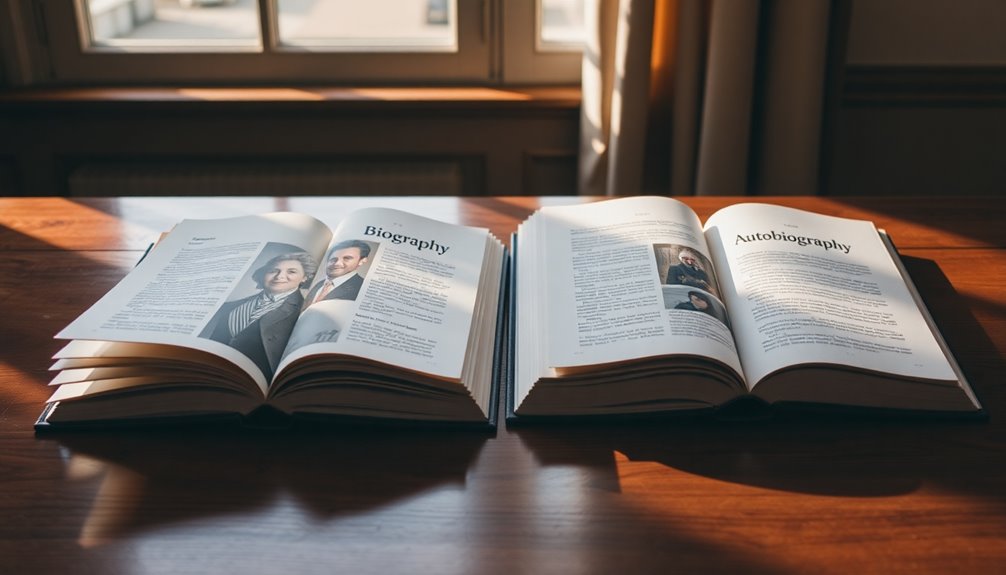
When you explore narrative structure in biographies and autobiographies, you'll notice distinct differences in approach. Biographies often take a chronological route, presenting a balanced view of the subject's life, while autobiographies might choose a thematic style that highlights key personal insights. You'll also see how the first-person perspective in autobiographies contrasts with the third-person perspective in biographies, shaping the reader's connection to the story. This distinction in narrative style contributes to the overall educational value of these literary forms, as each offers unique insights into personal and societal experiences.
Chronological vs. Thematic Approach
While both biographies and autobiographies can be structured chronologically or thematically, the choice of narrative approach greatly influences how readers perceive the subject's life. A chronological structure typically presents events in the order they occurred. This method helps you trace the subject's journey through significant milestones, such as:
- Birthplace and early life: Understanding where the subject started shapes your view of their beginnings.
- Key achievements and challenges: Observing how they tackled these hurdles shows their growth and resilience over time.
- Later life reflections: Seeing how experiences culminate in their later years provides insight into their legacy.
On the other hand, a thematic approach organizes the narrative around central themes or issues. This allows you to explore the subject's life through specific lenses, such as:
- Personal growth: Focusing on transformative experiences can deepen your connection to their story.
- Social impact: Highlighting contributions to society reveals the subject's broader significance.
- Emotional journeys: Understanding feelings associated with events adds layers to the narrative.
Ultimately, the choice between chronological and thematic approaches shapes the depth and scope of the narrative you engage with.
First-Person vs. Third-Person
Narrative structure plays an essential role in shaping how a life story is conveyed, influencing both the emotional connection and the reader's understanding. In autobiographies, you experience the story through a first-person narrative. The author uses "I," "me," and "my," creating an intimate glimpse into their life. This personal voice allows you to feel their emotions and reflections, making their experiences resonate on a deeper level.
On the other hand, biographies adopt a third-person narrative. Here, the author uses "he," "she," "him," and "her" to describe the subject's life from an external perspective. This approach provides a more objective view, relying on research and interviews to present a well-rounded account. You get facts and insights about the individual without the emotional bias of personal experience.
When reading an autobiography, you connect with the author's inner thoughts and feelings. In contrast, biographies offer a structured, formal tone that informs you while maintaining distance from the subject's emotions. Ultimately, the choice of narrative structure considerably impacts how you perceive and engage with the life story being told.
Personal Insights vs. Objective Facts
Autobiographies often provide a wealth of personal insights that draw readers into the author's unique experiences and emotions. When you read an autobiography, you'll find a subjective narrative that captures the essence of the author's life. Here are three key elements that create this intimate atmosphere:
- Personal Reflections: You'll experience the author's emotions and thoughts as they reflect on pivotal moments in their life.
- Intimate Tone: The writing often feels like a conversation, pulling you closer to the author's world and feelings.
- Memory and Recollections: You'll discover stories shaped by the author's personal memories, adding a layer of authenticity to their experiences.
In contrast, biographies focus on objective facts, presenting a balanced account of the subject's life. Biographers conduct extensive research, relying on interviews and various sources to gather information. This approach allows them to provide a thorough view that includes personal, professional, and public dimensions of the subject.
While autobiographies immerse you in personal insights, biographies give you a factual understanding of a life, making each format unique in its narrative structure.
Emotional Impact

Exploring the emotional impact of autobiographies reveals a deeply personal and intimate connection between the author and the reader. In these narratives, you'll often encounter a more emotional tone, shaped by the author's reflections on their subjective experiences. This tone not only conveys their feelings but also invites you to empathize with their journey. As the author shares personal anecdotes and emotional responses to significant life events, the narrative becomes relatable and engaging.
The subjective nature of autobiographies allows the author's thoughts and memories to influence your perception, providing a unique insight into their inner life and personal growth. You'll likely find yourself connecting more deeply with their story due to the first-person perspective. This emotional and subjective approach sets autobiographies apart from biographies, which aim for objectivity through meticulous research and fact-checking.
In reading an autobiography, you're not just absorbing facts; you're experiencing the author's life alongside them. This intimate connection fosters empathy and understanding, creating a bond that can resonate long after you've turned the final page.
Examples and Notable Works

What makes certain autobiographies and biographies stand out in the literary world? The power of storytelling, depth of insight, and the ability to connect with readers elevate these works. Here are three notable examples that showcase this:
- The Diary of a Young Girl by Anne Frank: This poignant account of a girl's life during WWII immerses you in her world, evoking empathy and reflection.
- Steve Jobs by Walter Isaacson: Through extensive interviews, you gain a thorough view of Jobs' innovative mind and complex personality, revealing the man behind the tech revolution.
- I Know Why the Caged Bird Sings by Maya Angelou: This autobiography chronicles Angelou's struggles and triumphs, offering profound lessons on resilience and identity.
Notable biographers like Walter Isaacson and Rebecca Skloot have mastered the art of weaving personal stories with historical context. Their meticulous research and engaging narratives bring figures like Albert Einstein and Henrietta Lacks to life. Whether you're drawn to the personal reflections found in autobiographies or the detailed accounts in biographies, these works provide invaluable insights into the human experience.
Frequently Asked Questions
Can Autobiographies Be Written With the Help of a Ghostwriter?
Yes, you can definitely use a ghostwriter for your autobiography. While it's your personal story, a ghostwriter helps articulate your voice and experiences, making the writing process smoother and more engaging for readers.
Are Biographies Always Longer Than Autobiographies?
Biographies aren't always longer than autobiographies. Their length depends on the author's approach and the subject's life complexity. Some autobiographies can be quite detailed, while certain biographies might focus on specific themes or events.
Do Autobiographies Include References to Other People's Lives?
Surprisingly, 80% of autobiographies reference significant relationships. You'll find that they often include interactions with family, friends, and mentors, providing valuable insights into how those connections shaped the author's experiences and personal growth.
Can a Biography Be Written About a Fictional Character?
You can't write a true biography about a fictional character, since biographies focus on real individuals and their experiences. Fictional characters don't have actual lives to document, limiting their eligibility for biographical accounts.
Are There Different Types of Biographies and Autobiographies?
Yes, there're various types of biographies and autobiographies. You'll find authorized, unauthorized, historical, and celebrity biographies, along with full autobiographies, memoir-style, and spiritual ones. Each type offers unique perspectives on life experiences.

